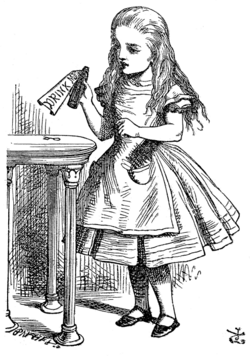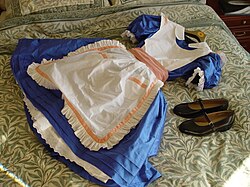Alice in Wonderland dress
 From Wikipedia - Reading time: 6 min
From Wikipedia - Reading time: 6 min

Alice from Alice's Adventures in Wonderland is one of the most iconic figures to emerge from 19th century children's literature, and one who is instantly recognized by her attire.[1] Although many artists have depicted Alice in many different ways, the original illustrations by John Tenniel have become iconic through their subsequent repetition (with generally minimal alterations) in most published editions and film adaptations.[2]
The headband depicted by Tenniel became so linked to Alice that it gave rise to the term "Alice band".[3][4]
Tenniel's Alice
[edit]Tenniel's black-and-white illustrations for Alice's Adventures in Wonderland depict Alice wearing a knee-length puffed sleeve dress with a pinafore worn over the top and ankle-strap shoes.[5]
In the analysis of Masafumi Monden,
Alice's sense of agency is further conveyed by her dress... Little girls' dresses in mid- to late nineteenth-century Europe were, even with certain restrictions, slightly more practical than adults', and the dress Alice wore in Tenniel's illustrations was a fashion current to the time of the book with a faint hint of the practical future ... Both the character and dress of Alice thus point out that she is neither assertive nor passive but is rather positioned comfortably in between the two.[2]
Lewis Carroll gave directions to Tenniel over some aspects of the dress. Tenniel's first design was intended to give Alice the look of a chess piece.[6][7][8] However, Caroll instructed Tenniel not to give it "so much crinoline",[6][7][8][9] a common component of women's dresses at the time.[10] Tenniel also changed the dress from book to book. In Through the Looking Glass, he gave Alice striped horizontal stockings and her (now eponymous) headband.[11] For The Nursery "Alice", he re-drew twenty of the illustrations, and brought Alice into line with contemporary fashion.[12][13] He not only coloured the dress yellow (discussed in detail later) but added a second bow to Alice's hair, a bow to the apron, and pleats.[12]
The colour of Alice's dress
[edit]
Neither the wording nor illustrations to Alice's Adventures in Wonderland indicated the colour of her clothes.[14] In a popular stage version of the story, staged by Henry Savile Clarke in 1886–87, Alice's costume was white (a decision endorsed for the next production by Lewis Carroll).[15]
The first colourised versions of Tenniel's images were created for The Nursery "Alice", coloured under his supervision. In this edition, Alice's dress was yellow.[13]
Subsequent colourised versions of Tenniel's illustrations created for editions of the Alice books after Charles Dodgson's death and without the involvement of Tenniel have dressed Alice in different colours, including red,[14] orange, and chartreuse.[16] DeLoss McGraw's illustrations used a range of colours.[17]
One of the earliest editions, Macmillan's 1903 "Little Folks" edition, had her in a blue dress.[16] Macmillan's deluxe 1911 edition, which featured colour plates based on Tenniel's illustrations painted by artist Harry Theaker, again had Alice in a blue dress.[16] Other illustrators also retained the blue colour scheme, including Helen Oxenbury.[17]
The blue dress later became the most common and well-known version of Alice's dress, showing up often in print and filmed adaptations that take their inspiration from Tenniel's original illustrations (including Paramount's 1933 movie, Disney's 1951 movie,[18] and the 1972 movie). Although some adaptations have chosen different colour schemes (for example, orange in the 1985 Irwin Allen production, yellow in the BBC's 1972[19] and 1986[20] adaptations as well as the 1999 Hallmark movie and lilac in The Royal Ballet's Alice's Adventures in Wonderland),[21] the blue version has remained the most iconic version.
Alice in other media
[edit]
It became fashionable for young girls to dress up as Alice when wearing fancy dress around the 1880s, by which time the fashion for everyday girls' dresses had changed enough that Alice's attire as depicted in the books had come to seem distinctive.[22]
Dresses explicitly inspired by Alice's were a recurrent feature of the range of the clothes makers Joseph Love, Inc. from the 1930s to the 1960s.[23] The style became especially popular in the USA when the Disney movie was released in 1951.[24]
More subtly, Alice's dress has been seen as an influence on Japanese dress styles, exhibited in music videos by, for example, Mizuki Alisa (in the video for her 1991 "Town of Eden"), Kawase Tomoko ("Bloomin'!", 2002) and Kimura Kae ("Snowdome", 2007).[25][26][27]
See also
[edit]Notes
[edit]- ^ Alice's Adventures in Wonderland (1865) by Charles Dodgson under the pseudonym Lewis Carroll
- ^ a b Monden 2014, pp. 269–271.
- ^ Chambers 21 Century Dictionary, rev. edn (Edinburgh: Chamber Harrap, 1999), s.v. Alice band.
- ^ "Alice, n.1." OED Online, Oxford University Press, March 2019, https://www.oed.com/view/Entry/4982. Accessed 24 March 2019.
- ^ Alice. "Pictures from Alice's Adventures in Wonderland". Alice-in-Wonderland.net.
- ^ a b Engen, Rodney K. (1991). Sir John Tenniel: Alice's White Knight. Scolar Press. p. 89. ISBN 9780859678728. Retrieved 28 March 2019.
- ^ a b Hancher, Michael (1985). The Tenniel illustrations to the "Alice" books. Ohio State University Press. p. 104. ISBN 9780814203743. Retrieved 28 March 2019.
- ^ a b Wakeling, Edward (2014). Lewis Carroll: The Man and his Circle. I.B.Tauris. p. 85. ISBN 9780857738516. Retrieved 28 March 2019.
- ^ Nichols 2014, p. 6.
- ^ Nichols 2014, p. 177.
- ^ Nichols 2014, p. 180.
- ^ a b Nichols 2014, p. 22.
- ^ a b Alice. "Pictures from the Nursery Alice". Alice-in-Wonderland.net.
- ^ a b Masuga, Katy (2011). "3. Through the Jabber - Lewis Carroll". Henry Miller and How He Got That Way. Edinburgh University Press. pp. 81, 94, n. 54. ISBN 9780748687671. Retrieved 28 March 2019.
- ^ Vaclavik 2014, p. 68.
- ^ a b c Peliano, Adriana (5 April 2011). "alicenations: Ask anyone what color Alice's dress is..."
- ^ a b Brooker 2005, p. 127.
- ^ Brooker 2005, p. 79.
- ^ "Alice Through the Looking-Glass" – via www.imdb.com.
- ^ "Alice in Wonderland" – via www.imdb.com.
- ^ Kirk, Sukie; Chan, Kat (21 September 2017). "Making Wonderland: the Australian Ballet's biggest show". The Guardian. Retrieved 28 March 2019.
- ^ Vaclavik 2014, pp. 68–69.
- ^ Jennifer Farley Gordon, 'The Development of the Designer Children's Wear Industry, 1920-1969' (Ph.D. dissertation, Iowa State University, 2016), pp. 94-95.
- ^ Shirley Miles O'Donnol (1989), American Costume 1915-1970, Indiana University Press, p. 165, ISBN 9780253113733
- ^ Monden 2014.
- ^ Monden 2019, pp. 214–219.
- ^ Myers 2016.
- Nichols, Catherine (2014). Alice's Wonderland: A Visual Journey Through Lewis Carroll's Mad, Mad World. Race Point Publishing. ISBN 9781937994976.
- Vaclavik, Kiera (2014). "The Dress of the Book: Children's Literature, Fashion and Fancy Dress". In Carrington, Bridget; Harding, Jennifer (eds.). Beyond the Book: Transforming Children's Literature. Newcastle Upon Tyne: Cambridge Scholars' Publishing. pp. 62–76.
- Monden, Masafumi (2014). "Being Alice in Japan: Performing a Cute, "girlish" Revolt". Japan Forum. 26 (2): 265–285. doi:10.1080/09555803.2014.900511. S2CID 143270185.
- Monden, Masafumi (2019). "A Dream Dress for Girls: Milk, Fashion and Shōjo Identity". In Berndt, J. (ed.). Shōjo Across Media. East Asian Popular Culture. Springer. pp. 209–231. doi:10.1007/978-3-030-01485-8_9. ISBN 978-3-030-01484-1. S2CID 194251806.
- Myers, Kali (2016). "Alice in transnational perspective and through the history of replication: an exploration of adult play in Australian art and Japanese shōjo culture". International Journal of Play. 5 (3): 292–305. doi:10.1080/21594937.2016.1217587. S2CID 152235341.
- Brooker, Will (2005). Alice's Adventures: Lewis Carroll in Popular Culture. Bloomsbury Publishing. ISBN 9780826417541.
Further reading
[edit]- Alice's clothing was the subject of a 2019 monograph by Kiera Vaclavik, Fashioning Alice: The Career of Lewis Carroll's Icon, 1860-1901 (London: Bloomsbury, 2019), ISBN 9781474290388
 KSF
KSF